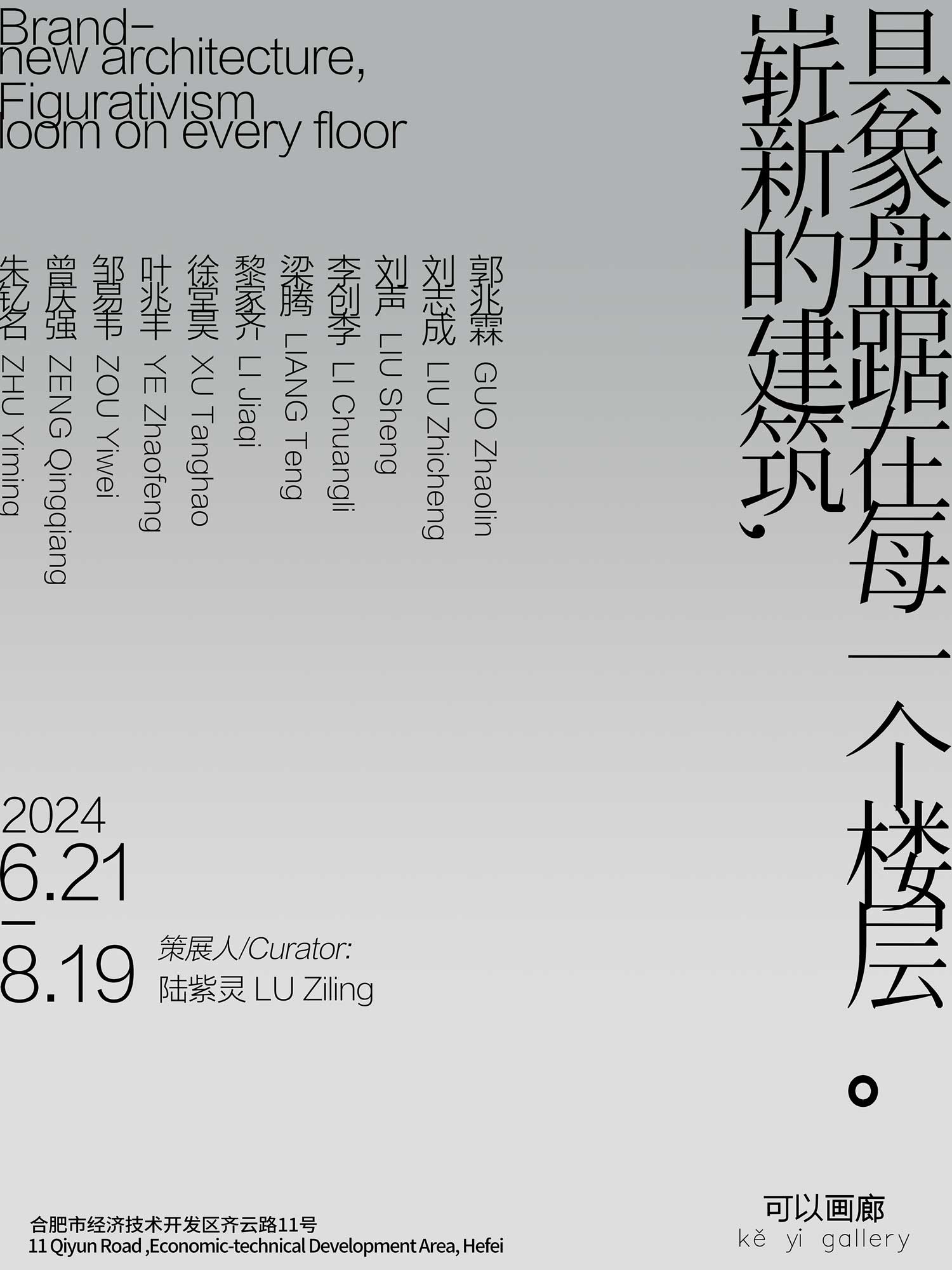展期 Period:
2024.6.21—2024.8.19
艺术家 Artist:
郭兆霖 Guo Zhaolin、刘志成 Liu Zhicheng、刘声 Liu Sheng、李创李 Li Chuangli、梁腾 Liang Teng、黎家齐 Li Jiaqi、徐堂昊 Xu Tanghao、叶兆丰 Ye Zhaofeng、邹易韦 Zou Yiwei、曾庆强 Rexy Tseng、朱钇名 Zhu Yiming
策展人 Curator:
地点 Venue:
前言 Introduction:
可以画廊欣然宣布即将于6月21日在合肥空间举办群展「崭新的建筑,具象盘踞在每一个楼层」。这将是在合肥厂房空间举办的最后一个展览,展览将集中呈现郭兆霖、刘志成、刘声、李创李、黎家齐、梁腾、徐堂昊、叶兆丰、邹易韦、曾庆强、朱钇名等11位艺术家的30余件新作。展期将持续至8月19日。
“艺术是一个不断发现的阶梯,但如果过度使用此阶梯,则会掉回地上。” ——安德烈·德朗
“万物在言说。”作为人类改造世界的第一个表现,建筑,不仅仅是一种知识体系,更好似“容器”般,借由钢筋混凝土的结构美学引领着艺术革命。而绘画,正是艺术这座巨大容器中无可比拟的关键结构。纵观艺术史的发展过程,传统绘画形式的追溯从古希腊到文艺复兴、经新古典、浪漫主义、印象及后印象派,在其漫长的绘画语言探索下开启了现代艺术思潮,包括野兽派、立体派、达达、超现实、波普等等。直至二十世纪初,在塞尚结构绘画的影响下,德朗放弃了主观表现,转向对对象的直观描摹,具象绘画的表现方式在彼时艺术家们对现代艺术运动的反思和探究中逐步确立。二十一世纪,具象绘画空前繁荣,我们不难发现,艺术风格总是在多元的社会背景下相互交替、更新,在照相技术高度发达的今天,各种新兴的艺术形式与之而来,“绘画过时、绘画已亡”的口号不断冲击着传统艺术形式,同时也考验着当代艺术家们的创作面貌,以及如何把握住符合每个时代节点的思考与表达。
贡布里希在《艺术的故事》中言:艺术史一直是“试图表现超越现实真理的艺术”和“优先参考现实世界的艺术”之间的交替;它使我们能够将这一理论应用于个人绘画,并更好地理解每幅画位于二元性的哪一边(抽象表现或具象现实),或者是否处于过渡时刻的边缘。绘画,记录着人们观看世界的方式。具象绘画作为传统艺术的重要一环,同时面临着当代艺术潮流的碰撞与挑战。今天,艺术家在以具象绘画为主进行创作时,除了内容主题形式的探索,也彰显了更多的个人经验与精神追求,从传统到现代的困境,也不单单是观看的方式,更多地涉及到人和世界的关联以及如何有意识地参与到对世界感知的建构中。
本次展览“崭新的建筑,具象盘踞在每一个楼层。”,通过探讨具象绘画的新面貌为主旨,以此呈现新、中生代的艺术家在个体经验的差异下对具象绘画的不同诠释,在将传统绘画技艺与艺术的当代性相结合的语境下,折射出他们看待世界的独特视角。
文/陆紫灵
KeYi Gallery is pleased to announce that a group exhibition titled "Brand-new architecture, Figurativism loom on every floor" will be held at Hefei Space on June 21st. This will be the last exhibition to be held in the factory space of Hefei, and the exhibition will focus on more than 30 new works by 11 artists, including Guo Zhaolin, Liu Zhicheng, Liu Sheng, Li Chuangli, Li Jiaqi, Liang Teng, Xu Tanghao, Ye Zhaofeng, Zou Yiwei, Zeng Qingqiang and Zhu Yiming. The exhibition will run until August 19th.
Gombrich in "The Story of Art" says: the history of art has always been an alternation between "art which tries to express something beyond real truth" and "art that prioritizes reference to the real world"; it enables us to apply this theory to individual paintings and better understand which side of each painting is in duality (abstract or figurative reality), or whether it is on the verge of transition. Painting records the way people view the world. Representational painting, as an important part of traditional art, is also facing collisions and challenges from contemporary art trends. Today, artists who create figurative paintings are not only exploring the themes, forms, and content of their works, but also demonstrates more personal experience and spiritual pursuit. The dilemma between tradition and modernity is not just about the way of viewing, but also involves the relationship between humans and the world, and how to consciously participate in the construction of the world's perception.
The exhibition "Brand-new architecture, Figurativism loom on every floor." exploring the new face of figurative painting, which presents the new and mid-career artists' different interpretations of figurative painting in the context of combining traditional painting techniques with the contemporary art.
Text by Lu Ziling

